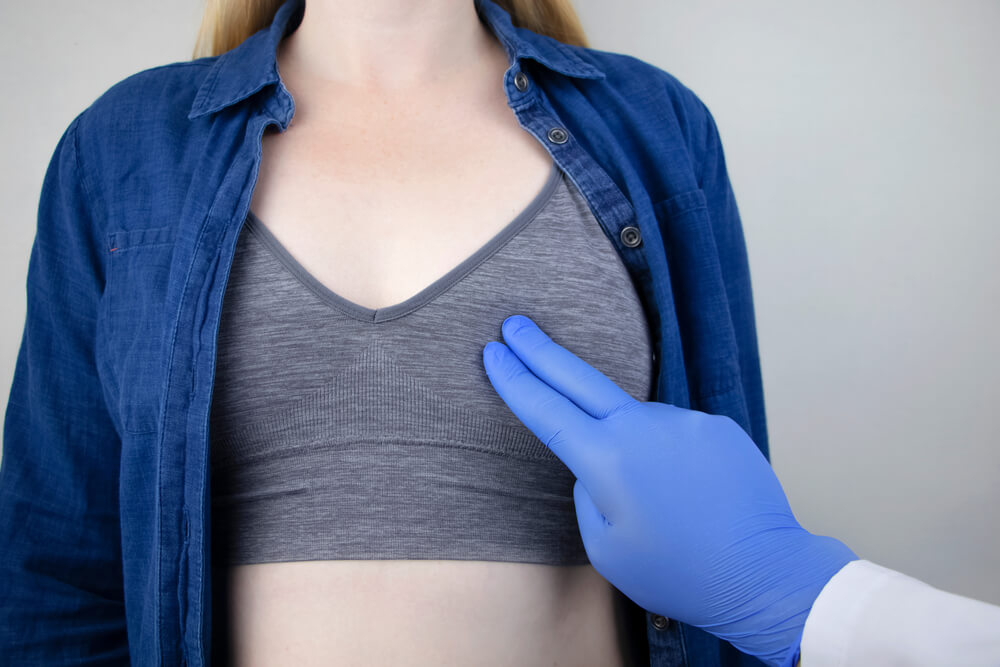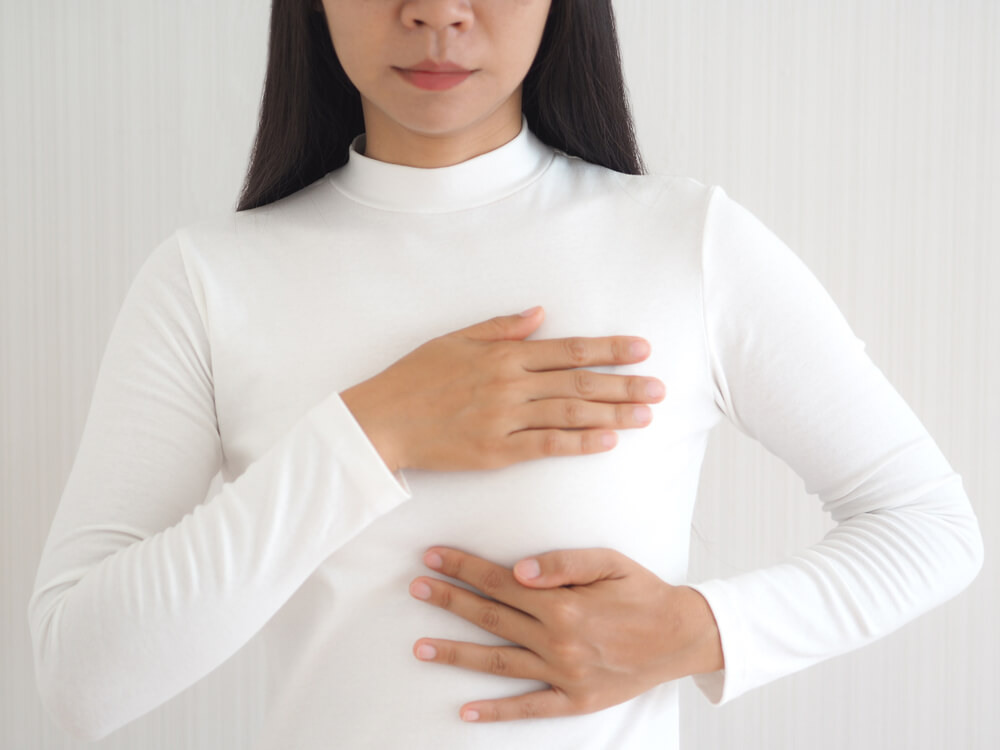Understanding Fibrocystic Breast Disease
Fibrocystic breast disease, characterized by the presence of noncancerous lumps and discomfort in the breasts, is a common condition that affects many women. Also known as fibrocystic breasts or fibrocystic breast changes, this condition involves the development of fluid-filled cysts and fibrous tissue in the breast.
In this article, the experts at Doral Beach Gynecology explore the causes behind fibrocystic breast disease and discuss fibrocystic breast changes while also talking about potential treatments.
If you still find that some of your questions remained unanswered after reading this article, or you want to explore your options regarding women’s reproductive health treatments in Doral & Miami Beach, feel free to reach out to our compassionate experts.
Unraveling the Causes of Fibrocystic Breast Disease

Hormonal Fluctuations
The intricate dance of hormonal fluctuations, particularly the dynamic interplay between estrogen and progesterone, lies at the heart of fibrocystic breast disease. Across the menstrual cycle, these hormones undergo ebbs and flows, orchestrating the cyclical changes in breast tissue. Estrogen, the primary female sex hormone, stimulates the growth of breast ducts, while progesterone, produced in higher quantities during the latter half of the menstrual cycle, prompts the maturation of these ducts. However, when this hormonal ballet encounters discord, it can manifest as fibrocystic breast changes.
During the premenstrual phase, estrogen and progesterone levels surge, creating an environment conducive to the development of cysts. These fluid-filled sacs form within the breast tissue, contributing to a palpable lumpiness and an overall increase in breast density. This cyclic expansion and contraction of breast tissue can result in tenderness, discomfort, and noticeable changes in breast texture.
Genetic Predisposition
Beyond the intricate choreography of hormones, genetic predisposition casts a significant shadow on the development of fibrocystic breasts. If you hail from a lineage where fibrocystic breast disease has left its imprint, there exists a higher likelihood that you may traverse a similar path. Genetic factors influence the susceptibility of breast tissue to hormonal cues, impacting the way it responds to the ebb and flow of estrogen and progesterone.
Researchers have identified specific gene variants associated with an increased risk of fibrocystic breast changes. These genetic nuances can influence the sensitivity of breast cells to hormonal signals, predisposing individuals to the development of cysts and heightened breast tissue density. Consequently, the familial thread woven with genetic intricacies may unravel as fibrocystic breast disease in subsequent generations.
Understanding the genetic underpinnings of fibrocystic breasts not only sheds light on individual risk but also underscores the importance of familial health histories. If fibrocystic breast disease has etched its presence in your family narrative, proactive measures, such as regular breast screenings and heightened awareness, become invaluable in navigating this genetic terrain.
Identifying Fibrocystic Breast Disease Symptoms
Palpable Lumps
A defining characteristic of fibrocystic breasts is the presence of palpable lumps or nodules nestled within the breast tissue. These lumps, often described as round or oval-shaped masses, can be discerned through the skin, becoming more pronounced and noticeable during specific phases of the menstrual cycle. This cyclical nature is a key feature, as the hormonal fluctuations that govern the menstrual cycle also influence the size and tenderness of these palpable lumps.
Before menstruation, when estrogen and progesterone levels peak, the breast tissue undergoes changes in response to hormonal cues. The lobules and ducts within the breast become engorged with fluid, resulting in the formation of cysts. These cysts, filled with fluid, contribute to the palpable texture of fibrocystic breasts. While generally benign, these lumps can cause discomfort and warrant attention during routine breast self-exams.
Breast Pain and Tenderness
A symphony of sensations unfolds in the breasts of women with fibrocystic breast disease, with breast pain and tenderness taking center stage. This discomfort is not a constant companion but rather follows a rhythmic pattern linked to the menstrual cycle. The premenstrual phase, characterized by heightened estrogen and progesterone levels, often ushers in increased breast sensitivity.
Many women experience breast pain and tenderness that intensifies in the days leading up to menstruation and gradually subsides afterward. This cyclical nature aligns with the hormonal fluctuations that influence breast tissue changes. The tenderness may be diffuse or localized to specific areas, adding to the complexity of interpreting these symptoms.
Fluctuations in Breast Texture
The landscape of fibrocystic breast disease extends beyond palpable lumps and embraces a spectrum of textural fluctuations. Women with this condition often describe changes in breast texture, which can manifest as a lumpy or rope-like feel. Certain areas of the breasts may exhibit increased firmness, contributing to an irregular texture that varies across the breast surface.
These fluctuations in texture are intricately tied to hormonal dynamics, with estrogen and progesterone orchestrating shifts in breast tissue density. The ebb and flow of these hormones throughout the menstrual cycle create a dynamic canvas where the tactile experience of the breasts evolves in harmony with hormonal cues.
Navigating Fibrocystic Breast Disease Treatment Options
Pain Management
For symptomatic relief, over-the-counter pain relievers and nonsteroidal anti-inflammatory drugs (NSAIDs) can help alleviate discomfort associated with fibrocystic breasts. Applying heat pads or taking warm baths may also provide relief.
Hormonal Therapies
In some cases, hormonal therapies, such as hormonal birth control or medications that regulate hormone levels, may be prescribed to address the hormonal fluctuations contributing to fibrocystic breast changes.
Cyst Drainage
For persistent or painful cysts, a healthcare provider may recommend draining the fluid from the cyst using a fine needle. This can provide relief and may also be done to rule out any concerning features.
Lifestyle Modifications
Certain lifestyle changes can contribute to managing fibrocystic breasts. Wearing a supportive bra, reducing caffeine intake, and maintaining a low-fat diet are strategies that some women find beneficial.
Seeking Professional Guidance
Regular Breast Exams: A Pillar of Proactive Health
Vigilance in breast health is a cornerstone of managing fibrocystic breasts, and regular breast examinations form an integral part of this proactive approach. Embracing routine breast self-exams empowers individuals to become familiar with the unique landscape of their breasts, facilitating the early detection of changes or abnormalities. This hands-on exploration, ideally conducted monthly, provides a valuable opportunity for individuals to identify palpable lumps, variations in breast texture, or any discomfort that warrants attention.
Clinical breast examinations conducted by healthcare providers add an additional layer of expertise to the monitoring process. These examinations, typically performed during routine check-ups, allow healthcare professionals to leverage their training and experience in assessing breast health. Through palpation and observation, clinicians can identify subtle changes, ensuring a comprehensive evaluation that complements individual self-exams. Regular clinical breast examinations establish a collaborative partnership between individuals and their healthcare providers, fostering open communication and proactive breast health management.
Diagnostic Imaging
When the need arises to delve deeper into breast changes or abnormalities, diagnostic imaging becomes a crucial tool in the diagnostic toolkit. Mammograms, ultrasounds, and MRIs serve as valuable allies in providing a comprehensive view of breast health.
Mammograms:
These X-ray images of the breast offer a detailed examination of breast tissue. Mammograms are instrumental in detecting changes that may not be palpable during a physical exam. For women with fibrocystic breasts, mammograms can help differentiate between benign cysts and potential areas of concern.
Ultrasounds:
Utilizing sound waves, ultrasounds provide a dynamic imaging perspective. This imaging modality is particularly useful in distinguishing between fluid-filled cysts and solid masses. For women with fibrocystic breasts, ultrasounds can offer clarity and aid in targeted assessments.
MRIs:

In some cases, healthcare providers may recommend magnetic resonance imaging (MRI) for a more detailed examination. MRIs offer high-resolution images, providing a comprehensive understanding of breast tissue and aiding in the identification of any anomalies.
While diagnostic imaging is a valuable component, it is essential to note that not all fibrocystic breast changes necessitate extensive imaging studies. The decision to pursue mammograms, ultrasounds, or MRIs is contingent on the individual’s specific symptoms, risk factors, and the findings of clinical examinations.
Embracing Awareness and Proactive Care
Fibrocystic breast disease is a common and benign condition that, while not directly linked to an increased risk of breast cancer, can cause discomfort and anxiety. By understanding the causes, recognizing symptoms, and exploring appropriate treatment options, women can navigate fibrocystic breasts with informed awareness and proactive care. Regular communication with healthcare providers ensures ongoing monitoring and support tailored to individual needs, promoting breast health and overall well-being.
If you have any more questions or concerns, feel free to schedule an appointment with us today.


